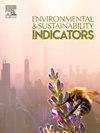Agricultural land around river confluences could strongly suppress floods occurrences
IF 5.4
Q1 ENVIRONMENTAL SCIENCES
引用次数: 0
Abstract
Flooding poses a significant threat to socioeconomic systems, with risks expected to escalate in the future due to factors such as climate change and urbanization. Ecosystem-based disaster risk reduction (Eco-DRR) emphasizes the role of natural and seminatural ecosystems, particularly agricultural ecosystems, in disaster impact mitigation such as by flood prevention benefits. This study evaluates the effectiveness of Eco-DRR in agricultural land around river confluences across Japan, where frequent flooding occurs. Using flood occurrence data from 2010 to 2018 in 1917 municipalities across Japan, statistical models were established incorporating agricultural land, urbanized areas, and the number of dams as explanatory variables to predict flood frequency. Previous studies have demonstrated that agricultural land located in the water storage zone contributes to flood suppression, whereas high land in urbanized areas is associated with increased flooding risk. Therefore, this condition was incorporated into the models. Two patterns were tested: one using all agricultural land and another focusing on agricultural land within a 1-km buffer around river confluences. The results demonstrate that agricultural land near river confluences significantly enhances flood suppression compared to all agricultural land. In contrast, urbanized areas within water storage zones were associated with increased flood risks. The findings suggest that conserving agricultural land in flood-prone confluence areas offers substantial flood mitigation benefits, whereas urban expansion in these areas heightens flood risks. Therefore, prioritizing the preservation of agricultural land around river confluences is crucial for flood risk reduction.
求助全文
约1分钟内获得全文
求助全文
来源期刊

Environmental and Sustainability Indicators
Environmental Science-Environmental Science (miscellaneous)
CiteScore
7.80
自引率
2.30%
发文量
49
审稿时长
57 days
 求助内容:
求助内容: 应助结果提醒方式:
应助结果提醒方式:


